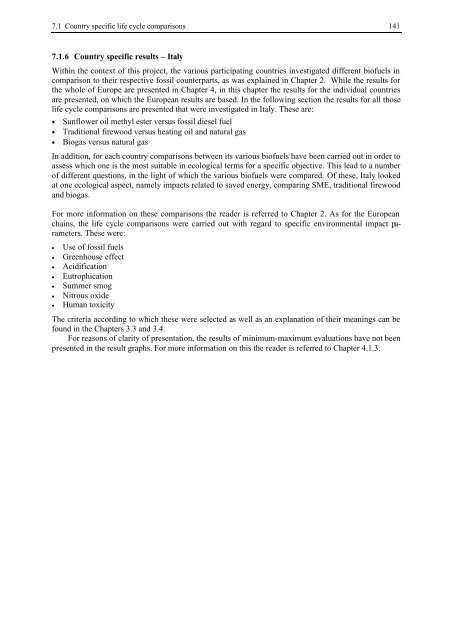BIOENERGY FOR EUROPE: WHICH ONES FIT BEST?
BIOENERGY FOR EUROPE: WHICH ONES FIT BEST?
BIOENERGY FOR EUROPE: WHICH ONES FIT BEST?
You also want an ePaper? Increase the reach of your titles
YUMPU automatically turns print PDFs into web optimized ePapers that Google loves.
7.1 Country specific life cycle comparisons 141<br />
7.1.6 Country specific results – Italy<br />
Within the context of this project, the various participating countries investigated different biofuels in<br />
comparison to their respective fossil counterparts, as was explained in Chapter 2. While the results for<br />
the whole of Europe are presented in Chapter 4, in this chapter the results for the individual countries<br />
are presented, on which the European results are based. In the following section the results for all those<br />
life cycle comparisons are presented that were investigated in Italy. These are:<br />
• Sunflower oil methyl ester versus fossil diesel fuel<br />
• Traditional firewood versus heating oil and natural gas<br />
• Biogas versus natural gas<br />
In addition, for each country comparisons between its various biofuels have been carried out in order to<br />
assess which one is the most suitable in ecological terms for a specific objective. This lead to a number<br />
of different questions, in the light of which the various biofuels were compared. Of these, Italy looked<br />
at one ecological aspect, namely impacts related to saved energy, comparing SME, traditional firewood<br />
and biogas.<br />
For more information on these comparisons the reader is referred to Chapter 2. As for the European<br />
chains, the life cycle comparisons were carried out with regard to specific environmental impact parameters.<br />
These were:<br />
• Use of fossil fuels<br />
• Greenhouse effect<br />
• Acidification<br />
• Eutrophication<br />
• Summer smog<br />
• Nitrous oxide<br />
• Human toxicity<br />
The criteria according to which these were selected as well as an explanation of their meanings can be<br />
found in the Chapters 3.3 and 3.4.<br />
For reasons of clarity of presentation, the results of minimum-maximum evaluations have not been<br />
presented in the result graphs. For more information on this the reader is referred to Chapter 4.1.3.

















